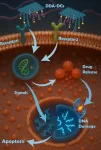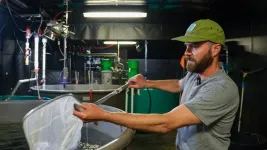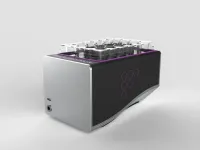(Press-News.org) CHAMPAIGN, Ill. — Drug-carrying DNA aptamers can deliver a one-two punch to leukemia by precisely targeting the elusive cancer stem cells that seed cancer relapses, researchers at the University of Illinois Urbana-Champaign report.
The aptamers — short single-strand snippets of DNA that can target molecules like larger antibodies do — not only deliver cancer-fighting drugs, but also are themselves toxic to the cancer stem cells, the researchers said.
Led by Xing Wang, a U. of I. professor of bioengineering and of chemistry, the researchers documented their findings in the journal Advanced Functional Materials.
“This work demonstrates a way to get to the root of leukemia,” Wang said. “Targeted cancer treatments often have problems with toxicity or efficacy. Our aptamers seek out these stem cells specifically and kill them effectively.”
Leukemia and other cancers of the blood are more difficult to target than cancers that produce localized tumors because the cancerous cells circulate throughout the body and can’t be surgically removed, said postdoctoral researcher Abhisek Dwivedy, first author of the paper. Leukemia has a high rate of relapse due to its evasive stem cells. Though they make up a tiny fraction of cancerous cells, leukemia stem cells have the ability to evade chemotherapy by retreating to the bone marrow, since they share markers and properties, Dwivedy said. The cancerous cells can lurk, sometimes for years, and later proliferate and migrate.
“It’s important in leukemia, lymphoma or other blood cancers that we actually target and eliminate these stem cells, because as long as any are remaining, they can cause relapse and secondary cancers,” Dwivedy said.
The researchers began by finding DNA aptamers that seek out markers found on the surface of acute myeloid leukemia stem cells. They wanted to target not just the cancer, but the stem cells specifically.
“A big thing we showed in this study is that having two targets is better than one in terms of selectivity,” Wang said. “There are known antibody-drug conjugates for blood cancers that target one marker, but that marker is also found on a lot of healthy cells. So there is a lot of toxicity associated with antibody conjugates. But we used two targets: a combination often found in leukemia cancer cells and leukemia stem cells. The two together give a very specific target.”
The researchers then paired their aptamers with the leukemia-fighting drug daunorubicin. The drug-laden aptamers carry the drug to their target, then release the drug once inside the cell so the drug can act.
“This is especially important for drugs like daunorubicin, because the drug on its own cannot cross the cell membrane easily. But aptamers can carry it in,” Dwivedy said.
The researchers tested the drug-delivering aptamers in leukemia cell cultures as well as in live mice with leukemia.
After 72 hours, the aptamer alone had reduced the cancer cells in culture by 40 percent, demonstrating the aptamer’s toxicity to the cancer, the researchers report. When the aptamers carried the leukemia-fighting drug, the cells were wiped out with a dose 500 times smaller than the standard dosage of the drug. In mice with leukemia, delivering the drug via aptamer yielded the same efficacy at a dose 10 times smaller than the clinical standard, showing that the one-two punch of the aptamer and drug is more effective than either alone.
“This was exciting to us, because in cancer research, what we see in vitro is not always what we see in the body. Yet we saw excellent survivability and tumor reduction in the mice treated with our aptamer-drug conjugates, at one-tenth of the therapeutic dose, and no off-target effects,” Wang said.
The researchers said they hope to expand their suite of drug-delivering aptamers by identifying key marker combinations for other cancers, as well as coupling the aptamers with other drugs.
“Every cancer cell has a signature in its surface biomarkers. If we can find markers that are present uniquely in cancer cells, we can target other cancer types as well. Also, in my experience, it’s much easier to pair a drug with the DNA molecules than proteins, so that opens possibilities for delivering more drugs this way,” Dwivedy said.
The National Institutes of Health and the National Science Foundation supported this work. Wang is affiliated with the Cancer Center at Illinois, the Carl R. Woese Institute for Genomic Biology and the Holonyak Micro and Nanotechnology Lab at the U. of I.
Editor's note:
To reach Xing Wang, email xingw@illinois.edu.
The paper “Engineering novel DNA nanoarchitectures for targeted drug delivery and aptamer mediated apoptosis in cancer therapeutics” is available online. DOI: 10.1002/adfm.202425394
This work was supported by NSF grant 2127436 and NIH grant R21EB031310.
A provisional patent has been filed based on part of the reported study.
END
Drug-delivering aptamers target leukemia stem cells for one-two knockout punch
2025-04-03
ELSE PRESS RELEASES FROM THIS DATE:
New study finds that over 95% of sponsored influencer posts on Twitter were not disclosed
2025-04-03
New INFORMS journal Marketing Science Article Key Takeaways:
Over 95% of sponsored influencer posts on Twitter were not disclosed.
Influencer sponsorship arrangements with younger brands are less likely to be disclosed.
A large number of consumers can’t detect the sponsorship arrangement without disclosure.
The consumer-protection regulatory environment around undisclosed sponsorships has lagged behind.
BALTIMORE, MD, April 3, 2025 – New research in the peer-reviewed journal Marketing Science has found that 95% of influencer posts on Twitter (now X), which are sponsored, are not disclosed.
The ...
New sea grant report helps great lakes fish farmers navigate aquaculture regulations
2025-04-03
DULUTH, Minn.–Fish farmers across the Great Lakes states can face a confusing web of permits, policies and regulations that can hinder the growth of their operations. A new Sea Grant publication, Aquaculture Regulations in the Great Lakes, offers much-needed clarity.
The report breaks down complex legal frameworks and provides practical insights to help aquaculture producers understand and navigate state and regional requirements with greater confidence. It was developed by the National Sea Grant Law Center (NSGLC) ...
Strain “trick” improves perovskite solar cells’ efficiency
2025-04-03
Solar energy is one of the most promising solutions for reducing our dependence on fossil fuels. But making solar panels more efficient is a constant challenge. Perovskite solar cells (PSCs) have been a game-changer, offering rapid improvements in efficiency and potential for low-cost manufacturing. However, they still suffer from energy losses and operational stability issues.
The challenge with wide-bandgap perovskites
Perovskite solar cells, particularly those used in tandem configurations, rely on wide-bandgap (WBG) materials—semiconductors that absorb higher-energy ("bluer") ...
How GPS helps older drivers stay on the roads
2025-04-03
How GPS helps older drivers stay on the roads
Peer reviewed – observational study - humans
Sat Nav systems help keep older drivers on the roads for longer, according to new research from the University of East Anglia.
A new study published today reveals that over 65s with a poorer sense of direction rely more on help from GPS navigation systems such as Sat Nav or smartphone maps.
Those using GPS tended to drive more frequently - suggesting that the technology helps older people maintain driving independence.
Senior author Prof Michael Hornberger, from UEA’s Norwich Medical School, said: “Driving is usually the preferred mode of transport among ...
Estrogen and progesterone stimulate the body to make opioids
2025-04-03
Scientists have discovered a new mechanism that acts via an immune cell and points toward a different way of treating chronic pain.
Female hormones can suppress pain by making immune cells near the spinal cord produce opioids, a new study from researchers at UC San Francisco has found. This stops pain signals before they get to the brain.
The discovery could help with developing new treatments for chronic pain. It may also explain why some painkillers work better for women than men and why postmenopausal ...
Dancing with the cells – how acoustically levitating a diamond led to a breakthrough in biotech automation
2025-04-03
Engineers at a University of Bristol spin-out company have created a new technology that can move cells without touching them, enabling critical tasks that currently require large pieces of lab equipment to be carried out on a benchtop device.
The invention could accelerate the discovery of new medicines and unlock personalised medicine screening in clinics.
The groundbreaking concept was unveiled for the first time today in an article in Science published by Dr Luke Cox, where he describes his journey from University of Bristol ...
Machine learning helps construct an evolutionary timeline of bacteria
2025-04-03
University of Queensland scientists have helped to construct a detailed timeline for bacterial evolution, suggesting some bacteria used oxygen long before evolving the ability to produce it through photosynthesis.
The multinational collaboration – led by researchers from the Okinawa Institute of Science and Technology, the University of Bristol, Queensland University of Technology and UQ – focused on how microorganisms responded to the Great Oxygenation Event (GOE) about 2.33 billion years ago, which changed ...
Cellular regulator of mRNA vaccine revealed... offering new therapeutic options
2025-04-03
A team of researchers led by Dr. KIM V. Narry, director of the Center for RNA Research at the Institute for Basic Science (IBS), has uncovered a key cellular mechanism that affects the function of mRNA vaccines and therapeutics. Their study, recently published in Science, provides the first comprehensive understanding of how mRNA vaccines are delivered, processed, and degraded within cells—a breakthrough that could pave the way for more effective vaccines and RNA-based treatments.
Messenger RNA (mRNA) is the genetic blueprint that tells cells how to produce proteins. It plays a vital role in mRNA vaccines, such as those used for COVID-19, and is also a promising ...
Animal behavioral diversity at risk in the face of declining biodiversity
2025-04-03
Our environment is changing rapidly, largely as a result of human activities, leading to a significant decline in biodiversity. According to researchers from the University of Victoria and the Max Planck Institute for Evolutionary Anthropology, this decline does not only affect animal life, but also our understanding of their behavior, including tool use.
"Cultural behaviors range from the songs of whales to the tool use of primates," says Ammie Kalan of the University of Victoria. "These adaptations to environmental change not only benefit the animals, but also provide important insights into the origins of behavior and learning across species. However, shrinking ...
Finding their way: GPS ignites independence in older adult drivers
2025-04-03
GPS tech may empower older adults to be more adventurous on the road, according to a study published April 3, 2025 in the open-access journal PLOS Digital Health by Sol Morrissey from the University of East Anglia and colleagues.
Driving is older adults’ preferred transportation method, but age-related cognitive decline can limit time spent behind the wheel. Empowering older adults to be more mobile drivers (that is, driving more frequently and for longer distances) is critical to boosting physical, social and cognitive wellness. Electronic navigation systems ...




